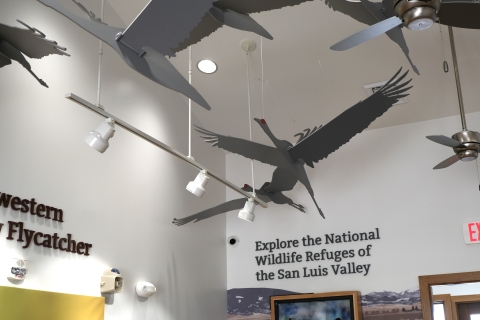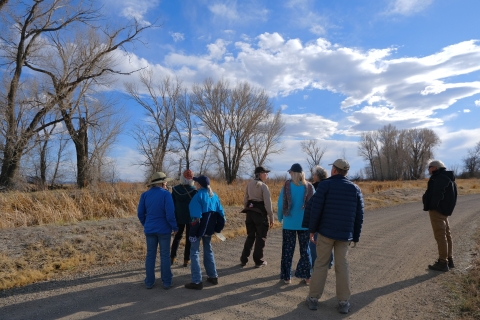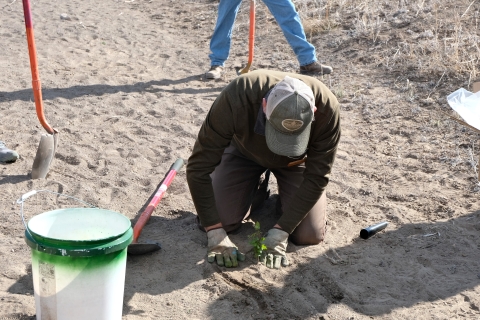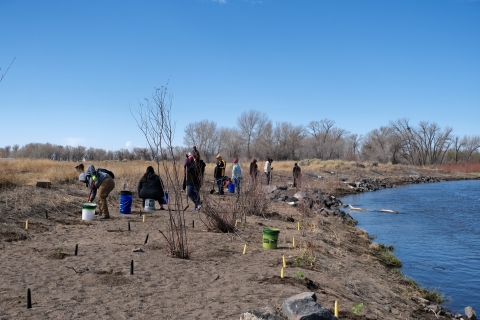The Grand Opening Event
Hands were joined and hugs were given as people gathered on April 19th to celebrate the grand opening of the new visitor center and headquarters office for the San Luis Valley National Wildlife Refuge Complex (Refuge Complex), located in Alamosa (7824 El Rancho Lane, Alamosa, CO 81101). Beautiful new interactive educational exhibits, along with light snacks, drew long-time friends and new faces to Alamosa National Wildlife Refuge. At the ‘come as you can’ event, people connected with each other, Refuge Complex staff and the Friends of the San Luis Valley National Wildlife Refuges (Friends Group), all uniting for conservation and community. As the sun neared the horizon, Refuge Manager (of Alamosa and Monte Vista National Wildlife Refuges) Suzanne Beauchaine led a wildlife walk where a multitude of birds and porcupine were spotted.
About the San Luis Valley
The San Luis Valley (Valley) is a high mountain, desert basin located in south-central Colorado. The Ute, Navajo, Jicarilla Apache, Cheyenne, Arapaho, multiple Pueblos and other Tribal nations call this valley home.
Alamosa, Monte Vista and Baca National Wildlife Refuges (Refuges) are located in the valley and are combined administratively into the San Luis Valley National Wildlife Refuge Complex. The diverse combination of habitats, that include wetlands, shrublands, grasslands and riparian riparian
Definition of riparian habitat or riparian areas.
Learn more about riparian areas, offer sanctuary for wildlife, especially migratory birds. With an abundance of wildlife on these protected lands, the Refuges offer opportunities to immerse oneself in the elements of nature.
Conservation Efforts in the Valley
The Refuge Complex works closely with the Friends Group, partnering organizations and volunteers for much of their conservation efforts. The Friends Group is an independent, non-profit group dedicated to supporting the U.S. Fish and Wildlife Service Refuge System. Without partnership and collaboration, the Refuge Complex’s conservation and community efforts would be limited drastically. With the strength and passion of the staff, local communities and organizations, the historic floodplains of the Valley are being restored. Some notable efforts include the clean-up of tons of material in the riverbanks, building floodplain terraces to allow high water to spread out instead of eroding banks and planting native species.
The day after the grand opening of the visitor center, Refuge staff gathered with the Rio Grande Headwaters Restoration Project, Alamosa City, Colorado State Forest Service and volunteers to clean-up trash and plant native willow, cottonwood trees, chokecherry and currents along the Rio Grande river. Through partnerships and hands on restoration, riverbanks are given the chance to restabilize and house more biodiversity. With more native plants along the landscape, soils can withstand against erosion from flooding, allowing for more carbon sequestration. Restoring these landscapes also returns habitats to native fauna, like the endangered southwestern willow flycatcher, Rio Grande sucker and Swainson’s hawk.
Get Involved
Conservation would not be the same without the help of our friends, neighbors, communities and a multitude of organizations. See how you can get involved by checking out the Refuge Complex’s Facebook and the Friends Group’s website for opportunities. For more information, visit the websites for Alamosa, Monte Vista and Baca National Wildlife Refuge.









